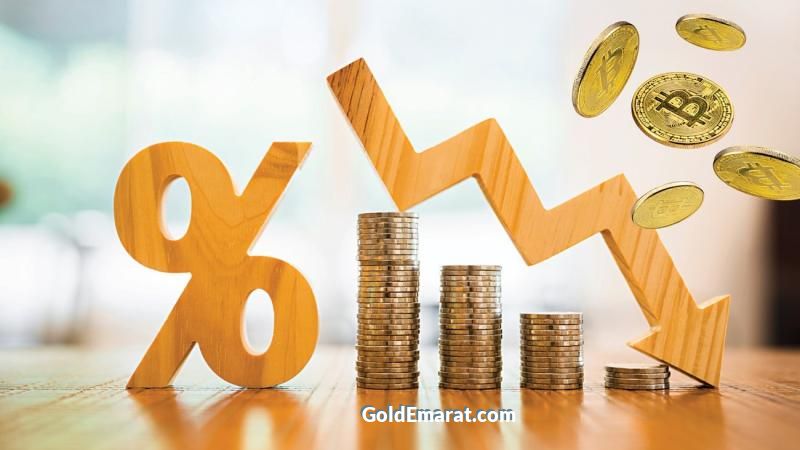Financial Experts: Stocks, Gold, and Cryptocurrencies Benefit Most from Rate Cuts
Thursday 18 Sep 2025 02:42 AM

Experts and financial analysts have identified several sectors that will be impacted by the U.S. Federal Reserve's decision to cut interest rates. They agree that the appeal of stocks increases when bank interest rates decrease and the return on money markets softens. They mentioned that the decision might pressure the U.S. dollar and bonds, contributing to new upward trends for gold, especially with strong central bank purchases and strong ETF inflows.
They emphasized that the reduction in U.S. interest rates would boost cryptocurrency prices, while noting that lower interest rates tighten net interest margins for banks. However, banks might benefit from loan growth and reduced default risks. They also pointed out that a weaker dollar typically attracts flows to emerging markets, easing the burden of foreign debt and supporting the performance of REITs. The rate cut is expected to boost real estate demand and home purchases in the U.S., with potential decreases in mortgage rates influencing developers who borrow for projects. The significance of the Federal Reserve meeting lies in predicting future paths more than the rate decision itself.
Last year, the U.S. Federal Reserve cut rates three times consecutively, and this decision is the first of its kind in 2025, potentially followed by additional cuts later in the year.
Haitham Adhama, CEO of the Financial Services Group at Al Ramz Corporation for Investment and Development, outlined the winners and losers from the U.S. Federal Reserve's interest rate decision. He stated that the expected decline in returns on bank deposits, bonds, and sukuk generally reflects positively on stock investments, making them more attractive to investors. He explained that the drop in U.S. interest rates particularly affects U.S. stock markets, as capital inflows increase with the shift from deposits and bonds to U.S. stocks.
He continued that lower interest rates enhance gold's appeal as a safe haven during economic volatility, especially with the expected weakness in the U.S. dollar. Cryptocurrencies also benefit from lower interest rates, now viewed as forms of safe havens. However, the banking sector might partly suffer from reduced interest earnings, with an estimated impact ranging between 3% to 5%. Yet, lower interest rates might increase the allure of bank loans and funding, potentially expanding credit provided by banks.
Adhama added that despite low-interest rates decreasing the appeal of returns on sukuk and bonds, they might encourage more issuances by companies and governments due to reduced costs. He highlighted that the effect of interest rate cuts on investment flows and government debts varies depending on the currency's linkage to the U.S. dollar. For example, emerging markets might be less affected than the U.S. as debt levels remain stable, and new debt instrument issuances are limited compared to the U.S.
Vijay Valecha, Chief Investment Officer at Century Financial, said that investor optimism over the moderate labor market and falling inflation would give the U.S. Federal Reserve confidence to begin a long-awaited easing cycle, leading to continued surges in U.S. stocks last week. This marks one of the fastest upward waves in five decades.
The U.S. Dollar Index fell by 0.12% last week, continuing to trade at low levels as investors awaited the rate-cut decision, possibly pressuring the dollar.
Gold has maintained its rise since late August to mid-September, bolstered by strong expectations for a 25-basis-point rate cut in September, with weak labor market data pressuring bond yields and the U.S. dollar, driving gold's ascension.
Strong central bank purchases, robust ETF flows, and uncertainty over Trump policies increased demand for gold as a safe haven. ETF flows rose by $80.3 trillion in Q2 this year, and breaking through the $3,675 level could trigger a new upward wave.
Daniela Sabin Hawthorne, a senior analyst at Capital Dot Com, noted that global markets seemed relaxed before the interest rate decision announcement, with stocks near their highs and much of the easing already priced in.
She indicated that futures contracts show almost complete agreement on a 25-basis-point U.S. interest rate cut, with a faint possibility of a larger 50-basis-point cut. This direction reflects a mix of recent data and developments justifying easing, although it does not support a significant step.
Hawthorne emphasized that the focus in the Federal Reserve meeting would be on the future path more than the decision itself, meaning economic projections and the dot plot will be the primary market guide.
A divided vote or opposition to a rate cut would indicate internal debate, increasing uncertainty about the rate's trajectory.
Charu Chanana, Head of Investment Strategies at Saxo Bank, said that with declining money market returns, investors can redeploy liquidity into bonds for yield, stocks for growth, or real assets like gold and infrastructure for diversification. She mentioned that stocks usually benefit from easing monetary policies, as lower interest rates reduce financing costs and improve valuations, with opportunities expanding beyond major tech firms.
She stressed that low-interest rates narrow net interest margins in the banking sector, particularly if loan yields drop faster than deposit costs, meaning banks might initially struggle with benefits at the onset of a rate cut. However, if the easing cycle extends and maintains healthy credit conditions, banks could benefit from loan growth and reduced default risks.
Emerging market banks often gain from a weak U.S. dollar and capital inflows. Chanana sees high-quality fixed income instruments like bonds offering an attractive yield-risk diversification mix. Lower interest rates might decrease treasury yields, allowing government bonds and investment-grade bonds to achieve moderate single-digit returns over the next year.
A weak dollar typically attracts inflows to emerging markets, easing the external debt burden and supporting stock performance. Any sector combining large capital investments with long-term cash flows—like mining, utilities, renewable energy, infrastructure, pipelines, and real estate funds—might see bigger gains from reduced financing costs. She concluded by reaffirming that tying these capital-intensive sectors to structural demand themes like AI energy, electrification, and energy transition strengthens the outlook.
Enrique Diaz Alvarez, Chief Analyst at Ebury, observed increasing indicators of a slowing labor market, doubling pressure on the Federal Reserve to cut interest rates while stocks continue scaling new heights incongruent with economic realities.
He noted the U.S. dollar remained solid, possibly due to the challenges facing major competitors, like sustained recession in the eurozone and worsening stagflation in the UK, affirming that gold stands out as the biggest beneficiary.
Simon Peters, Cryptocurrency Analyst at eToro, confirmed that Bitcoin's price rose by 4% last week, surpassing the $116,000 mark, driven by more moderate U.S. inflation data and continued signs of labor market weakness.
This rise coincided with five consecutive days of positive inflows to spot Bitcoin ETFs, totaling $2.32 billion, indicating renewed institutional interest in cryptocurrencies amidst expectations of rate cuts.
Gold Market News

15 Dec 2025

12 Dec 2025



